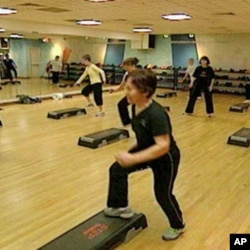A new study indicates that combining aerobics and weight lifting can help people with Type 2 diabetes keep their blood sugar levels under control.
Most people probably think of diabetes control in terms of diet or insulin, but Dr. Tim Church says exercise can play a big role.
"If you look at what diabetes is, it's the failure of the body to manage the blood sugar, and the biggest consumer of blood sugar in the human body is skeletal muscle," he says. "So if you keep skeletal muscle happy, it's chewing up blood sugar 24 hours a day."
Church is a researcher at Louisiana State University's Pennington Center. He says most previous studies looked at the impact on diabetes of one kind of exercise only - typically aerobic exercise, like walking or bicycling. So he and his colleagues recruited more than 250 patients with diabetes and randomly assigned them to an aerobic exercise group, a weightlifting group, a group that did both kinds of exercise, or a control group that had no organized exercise program.
After nine months, he said, the results were clear.
"And for virtually everything we looked at, but in particular related to hemoglobin A1C - that represents blood sugar control - the group that did both the walking and the resistance training, or weight lifting, did by far the best."
Church said he expected that the group that did both kinds of exercise would do better, but he was surprised by how much better they did - not just on controlling blood sugar, but on other relevant measures as well, like weight. He said different kinds of exercise affect the body differently, especially the big muscles that are fueled by blood sugar.
"Skeletal muscle is so important for your health, and that's particularly true in individuals with diabetes," he explained. "And aerobic exercise affects skeletal muscle through one set of mechanisms, and the weight-lifting affects skeletal muscles through a completely different set of mechanisms. So when you combine aerobic plus the weight-lifting, you're doubling the opportunity for benefit."
The people in Church's study were diabetic adults, mostly in their 50s and older, so you might wonder if taking on a lot of exercise is a reasonable thing to ask. But he points out that the exercise routine in the combination group amounted to a bit more than two hours a week, which he said is do-able and actually less of a commitment that some previous studies have suggested was necessary.
Tim Church published his findings in the journal of the American Medical Association, JAMA.












